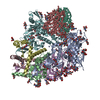+Search query
-Structure paper
| Title | Priming antibody responses to the fusion peptide in rhesus macaques. |
|---|---|
| Journal, issue, pages | NPJ Vaccines, Vol. 9, Issue 1, Page 126, Year 2024 |
| Publish date | Jul 12, 2024 |
 Authors Authors | Christopher A Cottrell / Payal P Pratap / Kimberly M Cirelli / Diane G Carnathan / Chiamaka A Enemuo / Aleksandar Antanasijevic / Gabriel Ozorowski / Leigh M Sewall / Hongmei Gao / Joel D Allen / Bartek Nogal / Murillo Silva / Jinal Bhiman / Matthias Pauthner / Darrell J Irvine / David Montefiori / Max Crispin / Dennis R Burton / Guido Silvestri / Shane Crotty / Andrew B Ward /   |
| PubMed Abstract | Immunodominance of antibodies targeting non-neutralizing epitopes and the high level of somatic hypermutation within germinal centers (GCs) required for most HIV broadly neutralizing antibodies ...Immunodominance of antibodies targeting non-neutralizing epitopes and the high level of somatic hypermutation within germinal centers (GCs) required for most HIV broadly neutralizing antibodies (bnAbs) are major impediments to the development of an effective HIV vaccine. Rational protein vaccine design and non-conventional immunization strategies are potential avenues to overcome these hurdles. Here, we report using implantable osmotic pumps to continuously deliver a series of epitope-targeted immunogens to rhesus macaques over the course of six months to prime and elicit antibody responses against the conserved fusion peptide (FP). GC responses and antibody specificities were tracked longitudinally using lymph node fine-needle aspirates and electron microscopy polyclonal epitope mapping (EMPEM), respectively, to show antibody responses to the FP/N611 glycan hole region were primed, although exhibited limited neutralization breadth. Application of cryoEMPEM delineated key residues for on-target and off-target responses that can drive the next round of structure-based vaccine design. |
 External links External links |  NPJ Vaccines / NPJ Vaccines /  PubMed:38997302 / PubMed:38997302 /  PubMed Central PubMed Central |
| Methods | EM (single particle) |
| Resolution | 3.37 - 3.9 Å |
| Structure data | EMDB-40822, PDB-8swv: EMDB-40823, PDB-8sww: EMDB-40824, PDB-8swx: EMDB-40981, PDB-8t2e: EMDB-40982, PDB-8t2f: |
| Chemicals |  ChemComp-NAG: |
| Source |
|
 Keywords Keywords | VIRAL PROTEIN/IMMUNE SYSTEM / HIV-1 / Env / NHP / Antibody / Fusion Peptide / Polyclonal / VIRAL PROTEIN / VIRAL PROTEIN-IMMUNE SYSTEM complex |
 Movie
Movie Controller
Controller Structure viewers
Structure viewers About Yorodumi Papers
About Yorodumi Papers














 human immunodeficiency virus 1
human immunodeficiency virus 1
